Effect of K and Zn Application on Biometric and Physiological Parameters of Different Maize Genotypes
Abstract
:1. Introduction
2. Material and Methods
2.1. Site Description
2.2. Experiment Details
2.3. Plant Harvest
2.4. Plant Analysis
2.4.1. Morphological and Yield Parameters
2.4.2. Physiological Parameters
2.4.3. Ionic Parameters
2.5. Statistical Analysis
3. Results
3.1. Effect of K and Zn Fertilization on Plant Height
3.2. Effect of Potassium and Zinc Application on Plant Fresh and Dry Biomass (g Pot−1)
3.3. Effect of Potassium and Zinc on Membrane Stability Index (MSI) and Relative Water Content (RWC)
3.4. Effect of Potassium and Zinc on Chlorophyll Contents (SPAD Value) and Cob Length (cm)
3.5. Effect of Potassium and Zinc on Gas Exchange Parameters
3.6. Effect of Potassium and Zinc on 1000 Grain Weight and Grain Yield of a Maize
3.7. Effect of Potassium and Zinc on K Concentration in Straw and Grain of a Maize
3.8. Effect of Potassium and Zinc on Zn Concentration in Straw and Grain of a Maize
4. Discussion
4.1. Effect of Potassium and Zinc Application on Growth Attributes of Maize Genotypes
4.2. Effect of Potassium and Zinc Application on Gas Exchange Parameters of Maize Genotypes
4.3. Effect of Potassium and Zinc Application on Physiological Attributes of Maize Genotypes
4.4. Effect of Potassium and Zinc Application on Yield Parameters of Maize Genotypes
4.5. Effect of Potassium and Zinc Application on Ionic Contents of Maize Genotypes
5. Conclusions
Author Contributions
Funding
Institutional Review Board Statement
Informed Consent Statement
Conflicts of Interest
References
- Menkir, A. Genetic variation for grain mineral content in tropical-adapted maize inbred lines. Food Chem. 2008, 110, 454–464. [Google Scholar] [CrossRef]
- Harris, D.; Rashid, A.; Miraj, G.; Arif, M.; Shah, H. “On-farm” seed priming with zinc sulphate solution-A cost-effective way to increase the maize yields of resource-poor farmers. Field Crop. Res. 2007, 102, 119–127. [Google Scholar] [CrossRef]
- Pakistan Bureau of Statistics. Agricultural Statistic of Pakistan; Minestry of Food, Agriculture and Livestock: Islamabad, Pakistan, 2019.
- Mehdi, S.S.; Ahsan, M. Coefficient of Variation, Inter-relationship and Heritability Estimates for Some Seedling Traits in Maize in C1 Recurrent Selection Cycle. Pak. J. Biol. Sci. 1999, 3, 181–182. [Google Scholar] [CrossRef]
- Raza, H.M.A.; Bashir, M.A.; Rehim, A.; Jan, M.; Raza, Q.-U.-A.; Berlyn, G.P. Potassium and zinc co-fertilization provide new insights to improve maize (Zea mays L.) physiology and productivity. Pak. J. Bot. 2021, 53, 2059–2065. [Google Scholar] [CrossRef]
- Rehim, A.; Saleem, J.; Bashir, M.A.; Imran, M.; Naveed, S.; Sial, M.U.; Ahmed, F. Potassium and Boron Fertilization Approaches to Increase Yield and Nutritional Attributes in Maize Crop. Technol. Dev. 2018, 37, 69–77. [Google Scholar] [CrossRef]
- Umar, S. Moinuddin Genotypic differences in yield and quality of groundnut as affected by potassium nutrition under erratic rainfall conditions. J. Plant Nutr. 2002, 25, 1549–1562. [Google Scholar] [CrossRef]
- Marschner, H. Marschner’s Mineral Nutrition of Higher Plants; Elsevier: Amsterdam, The Netherlands, 2012; Volume 89. [Google Scholar]
- Marschner, H. Mineral Nutrition of Higher Plants. Miner. Nutr. High. Plants 1995, 537–595. [Google Scholar] [CrossRef]
- Singh, J.; Sharma, H.L.; Singh, C.M. Effect of levels and phases of potassium application on growth parameters of Rice and Wheat. Inti. Symp. A Decad. Potassium Res. 2000, 16, 35–40. [Google Scholar]
- Broadley, M.R.; White, P.J.; Hammond, J.P.; Zelko, I.; Lux, A. Zinc in plants: Tansley review. New Phytol. 2007, 173, 677–702. [Google Scholar] [CrossRef]
- Singh, K. Response of Zinc Fertilization to Wheat on Yield, Quality, Nutrients Uptake and Soil Fertility Grown In a Zinc Deficient Soil. Eur. J. Acad. Essays 2014, 1, 22–26. [Google Scholar]
- Cakmak, I. Enrichment of cereal grains with zinc: Agronomic or genetic biofortification? Plant Soil 2008, 302, 1–17. [Google Scholar] [CrossRef]
- Chomba, E.; Westcott, C.M.; Westcott, J.E.; Mpabalwani, E.M.; Krebs, N.F.; Patinkin, Z.W.; Palacios, N.; Hambidge, K.M. Zinc Absorption from Biofortified Maize Meets the Requirements of Young Rural Zambian Children. J. Nutr. 2015, 145, 514–519. [Google Scholar] [CrossRef] [Green Version]
- Nuss, E.T.; Tanumihardjo, S.A. Maize: A paramount staple crop in the context of global nutrition. Compr. Rev. Food Sci. Food Saf. 2010, 9, 417–436. [Google Scholar] [CrossRef]
- Krebs, N.F. Update on zinc deficiency and excess in clinical pediatric practice. Ann. Nutr. Metab. 2013, 62, 19–29. [Google Scholar] [CrossRef] [PubMed]
- Bänziger, M.; Long, J. The potential for increasing the iron and zinc density of maize through plant-breeding. Food Nutr. Bull. 2000, 21, 397–400. [Google Scholar] [CrossRef] [Green Version]
- Maziya-Dixon, B.; Kling, J.G.; Menkir, A.; Dixon, A. Genetic variation in total carotene, iron, and zinc contents of maize and cassava genotypes. Food Nutr. Bull. 2000, 21, 419–422. [Google Scholar] [CrossRef]
- Fahad, S.; Hussain, S.; Saud, S.; Hassan, S.; Shan, D.; Chen, Y.; Deng, N.; Khan, F.; Wu, C.; Wu, W.; et al. Grain Cadmium and Zinc Concentrations in Maize Influenced by Genotypic Variations and Zinc Fertilization. Clean-Soil Air Water 2015, 43, 1433–1440. [Google Scholar] [CrossRef]
- Ortiz-Monasterio, J.I.; Palacios-Rojas, N.; Meng, E.; Pixley, K.; Trethowan, R.; Peña, R.J. Enhancing the mineral and vitamin content of wheat and maize through plant breeding. J. Cereal Sci. 2007, 46, 293–307. [Google Scholar] [CrossRef]
- Reeves, D.R. Metal-accumulating plants. In Phytoremediation Toxic Metals Using Plants to Clean Up Environment; John Wiley & Sons: Hoboken, NJ, USA, 2000. [Google Scholar]
- Rehim, A.; Khan, M.; Imran, M.; Bashi, M.A.; Ul-Allah, S.; Khan, M.N.; Hussain, M. Integrated use of farm manure and synthetic nitrogen fertilizer improves nitrogen use efficiency, yield and grain quality in wheat. Ital. J. Agron. 2020, 15, 29–34. [Google Scholar] [CrossRef] [Green Version]
- Bashir, M.A.; Rehim, A.; Liu, J.; Imran, M.; Liu, H.; Suleman, M.; Naveed, S. Soil survey techniques determine nutrient status in soil profile and metal retention by calcium carbonate. Catena 2019, 173, 141–149. [Google Scholar] [CrossRef]
- Barth, H.G.; Sun, S.T. Particle Size Analysis. Anal. Chem. 1989, 61, 143R–152R. [Google Scholar] [CrossRef]
- Walkley, A. A critical examination of a rapid method for determining organic carbon in soils—effect of variations in digestion conditions and of inorganic soil constituents. Soil Sci. 1947, 63, 251–264. [Google Scholar] [CrossRef]
- Richards, L.A. Diagnosis and improving of saline and alkaline soils. Soil Sci. Soc. Am. J. 1954, 18, 348. [Google Scholar]
- Bashir, M.A.; Wang, H.; Pan, J.; Khoshnevisan, B.; Sun, W.; Zhai, L.; Zhang, X.; Wang, N.; Rehim, A.; Liu, H. Variations in soil nutrient dynamics and their composition in rice under integrated rice-crab co-culture system. J. Clean. Prod. 2021, 281, 125222. [Google Scholar] [CrossRef]
- Sahrawat, K.L. Macro- and micronutrients removed by upland and lowland rice cultivars in West Africa. Commun. Soil Sci. Plant Anal. 2000, 31, 717–723. [Google Scholar] [CrossRef]
- Westerman, R.L.; Jones, J.B.; Case, V.W. Sampling, Handling, and Analyzing Plant Tissue Samples. 1990. Available online: https://doi.org/10.2136/sssabookser3.3ed.c15 (accessed on 29 November 2021).
- Sairam, R.K. Effect of Moisture Stress on Physiological Activities of Two Contrasting Wheat Genotypes. Indian J. Exp. Biol. 1994, 32, 584–593. [Google Scholar]
- Steel, R.; Torrie, J.; Dickey, D. Principles and Procedures of Statistics: A Biometrical Approach, 3rd ed.; McGraw Hill Book Co.: New York, NY, USA, 1997. [Google Scholar]
- Maqsood, M.A.; Hussain, S.; Aziz, T.; Ahmad, M.; Naeem, M.A.; Ahmad, H.R.; Kanwal, S.; Hussain, M. Zinc indexing in wheat grains and associated soils of southern Punjab. Pak. J. Agric. Sci. 2015, 52, 431–438. [Google Scholar]
- Jat, G.; Majumdar, S.P.; Jat, N.K.; Mazumdar, S.P. Potassium and zinc fertilization of wheat (Triticum aestivum) in Western arid zone of India. Indian J. Agron. 2013, 58, 67–71. [Google Scholar]
- Stepien, A.; Wojtkowiak, K. Effect of foliar application of Cu, Zn, and Mn on yield and quality indicators of winter wheat grain. Chil. J. Agric. Res. 2016, 76, 220–227. [Google Scholar] [CrossRef] [Green Version]
- Sharma, P.N.; Kumar, N.; Bisht, S.S. Effect of zinc deficiency on chlorophyll content, photosynthesis and water relations of cauliflower plants. Photosynthetica 1994, 30, 353–359. [Google Scholar]
- Bahadur, L.; Tiwari, D.D.; Mishra, J.; Gupta, B.R. Nutrient Management in Rice-Wheat Sequence under Sodic Soil. J. Indian Soc. Soil Sci. 2013, 61, 341–346. [Google Scholar]
- Pessarakli, M. Handbook of Photosynthesis; Taylor & Francis: Boca Raton, FL, USA, 2005; ISBN 9781420027877. [Google Scholar]
- Shabala, S.; Schimanski, L.J.; Koutoulis, A. Heterogeneity in bean leaf mesophyll tissue and ion flux profiles: Leaf electrophysiological characteristics correlate with the anatomical structure. Ann. Bot. 2002, 89, 221–226. [Google Scholar] [CrossRef] [PubMed] [Green Version]
- Subbarao, G.V.; Wheeler, R.M.; Stutte, G.W.; Levine, L.H. Low potassium enhances sodium uptake in red-beet under moderate saline conditions. J. Plant Nutr. 2000, 23, 1449–1470. [Google Scholar] [CrossRef] [PubMed] [Green Version]
- Weisany, W.; Sohrabi, Y.; Heidari, G.; Siosemardeh, A.; Ghassemi-Golezani, K. Changes in antioxidant enzymes activity and plant performance by salinity stress and zinc application in soybean (Glycine max L.). Plant Omics 2012, 5, 60–67. [Google Scholar]
- Sharma, N.; Gupta, N.K.; Gupta, S.; Hasegawa, H. Effect of NaCl salinity on photosynthetic rate, transpiration rate, and oxidative stress tolerance in contrasting wheat genotypes. Photosynthetica 2005, 43, 609–613. [Google Scholar] [CrossRef]
- Mafakheri, A.; Siosemardeh, A.; Bahramnejad, B.; Struik, P.C.; Sohrabi, Y. Effect of drought stress and subsequent recovery on protein, carbohydrate contents, catalase and peroxidase activities in three chickpea (cicer arietinum) cultivars. Aust. J. Crop Sci. 2011, 5, 1255–1260. [Google Scholar]
- Jiang, Y.; Huang, B. Drought and heat stress injury to two cool-season turfgrasses in relation to antioxidant metabolism and lipid peroxidation. Crop Sci. 2001, 41, 436–442. [Google Scholar] [CrossRef]
- Cakmak, I. Plant nutrition research: Priorities to meet human needs for food in sustainable ways. Plant Soil 2002, 247, 3–24. [Google Scholar] [CrossRef]
- Kaya, C.; Higgs, D. Growth enhancement by supplementary phosphorus and iron in tomato cultivars grown hydroponically at high zinc. J. Plant Nutr. 2001, 24, 1861–1870. [Google Scholar] [CrossRef]
- Iqbal, Z.; Abbas, F.; Ibrahim, M.; Ayyaz, M.M.; Ali, S.; Mahmood, A. Surveillance of heavy metals in maize grown with wastewater and their impacts on animal health in peri-urban areas of multan, Pakistan. Pak. J. Agric. Sci. 2019, 56, 321–328. [Google Scholar] [CrossRef]
- Hussain, A.; Ali, S.; Rizwan, M.; Zia ur Rehman, M.; Hameed, A.; Hafeez, F.; Alamri, S.A.; Alyemeni, M.N.; Wijaya, L. Role of Zinc–Lysine on Growth and Chromium Uptake in Rice Plants under Cr Stress. J. Plant Growth Regul. 2018, 37, 1413–1422. [Google Scholar] [CrossRef]
- Zulkarnain, W.M.; Ismail, M.R.; Ashrafuzzaman, M.; Saud, H.M.; Haroun, I.C. Rice growth and yield under rain shelter house as influenced by different water regimes. Int. J. Agric. Biol. 2009, 11, 566–570. [Google Scholar]
- Mohd Zain, N.A.; Ismail, M.R. Effects of potassium rates and types on growth, leaf gas exchange and biochemical changes in rice (Oryza sativa) planted under cyclic water stress. Agric. Water Manag. 2016, 164, 83–90. [Google Scholar] [CrossRef] [Green Version]
- Maleki, A.; Fazel, S.; Naseri, R.; Rezaei, K.; Heydari, M. The effect of potassium and zinc sulfate application on grain yield of maize under drought stress conditions. Adv. Environ. Biol. 2014, 8, 890–893. [Google Scholar]
- Bukhsh, M.A.A.H.A.; Ahmad, R.; Iqbal, J.; Mudassar Maqbool, M.; Ali, A.; Ishaque, M.; Hussain, S. Nutritional and physiological significance of potassium application in maize hybrid crop production. Pak. J. Nutr. 2012, 11, 187–202. [Google Scholar]
- Naveed, S.; Rehim, A.; Imran, M.; Bashir, M.A.; Anwar, M.F.; Ahmad, F. Organic manures: An efficient move towards maize grain biofortification. Int. J. Recycl. Org. Waste Agric. 2018, 7, 189–197. [Google Scholar] [CrossRef] [Green Version]
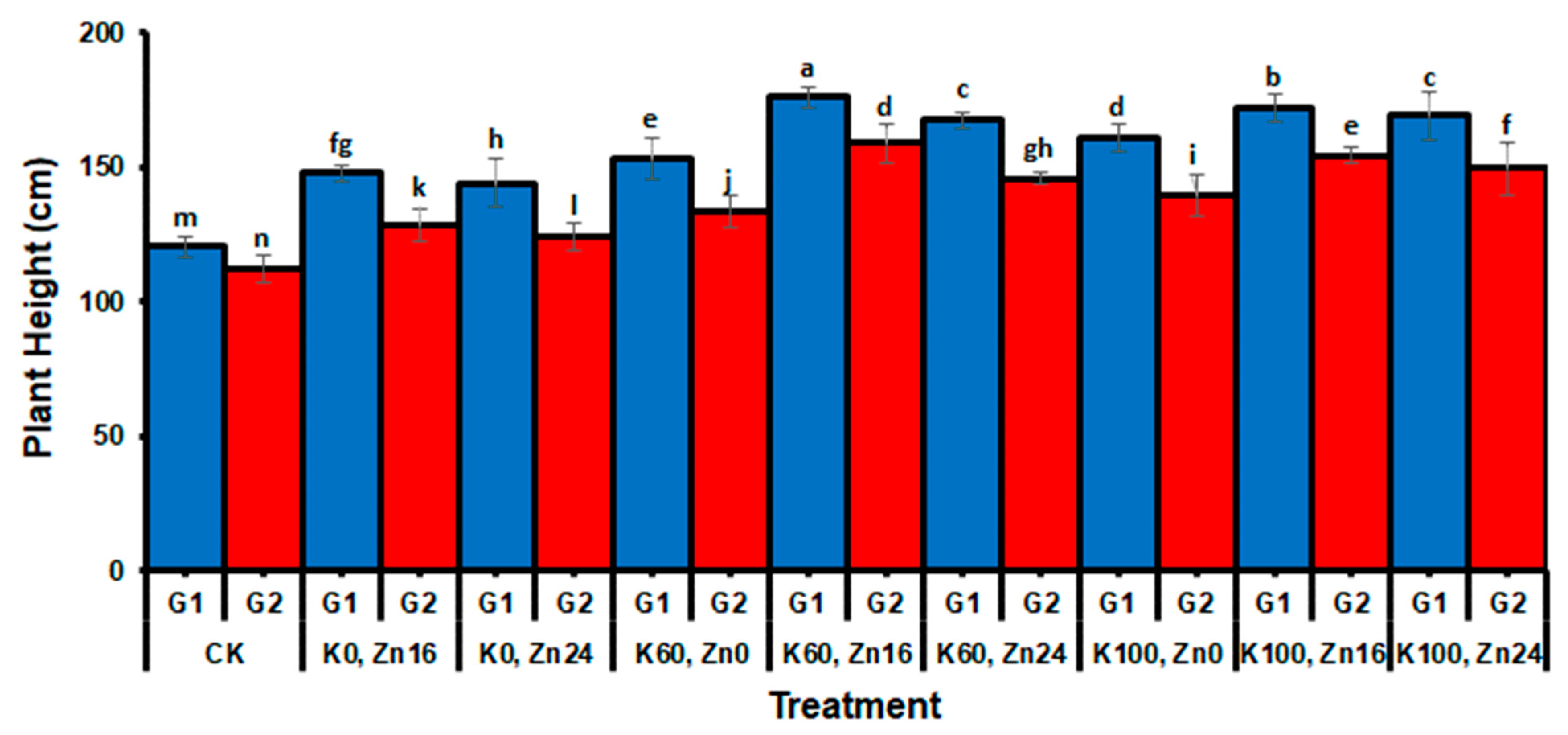
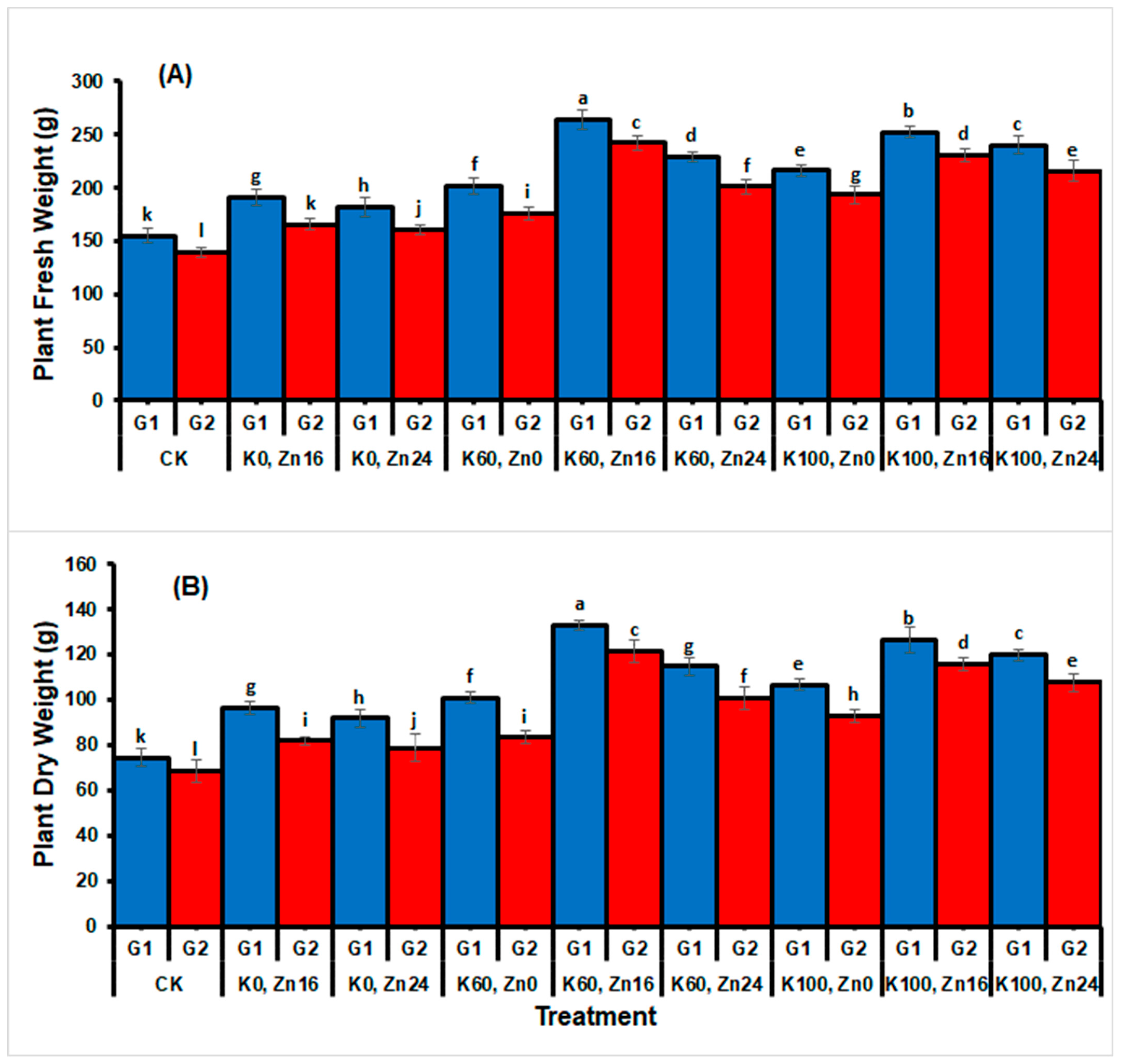
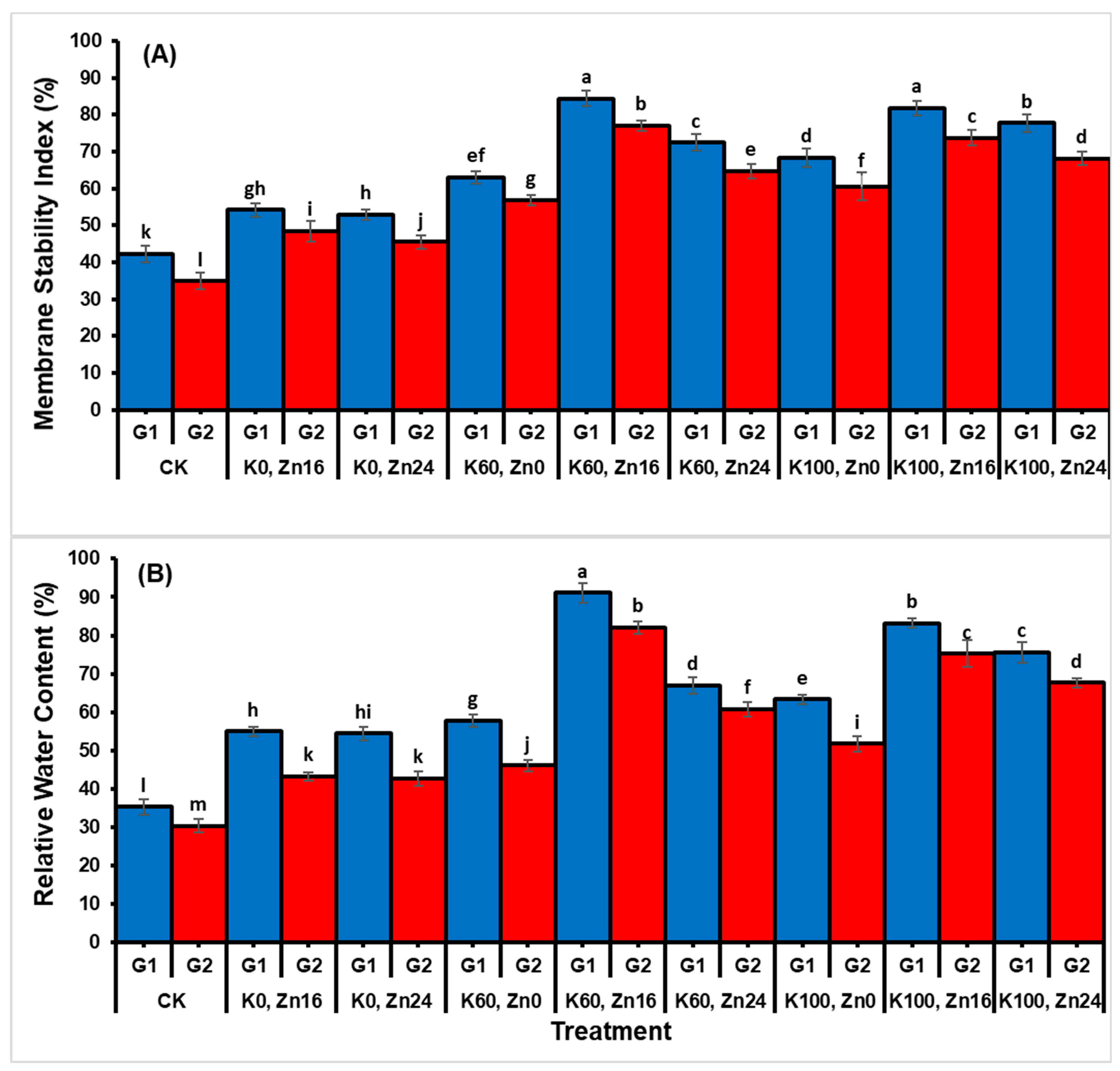
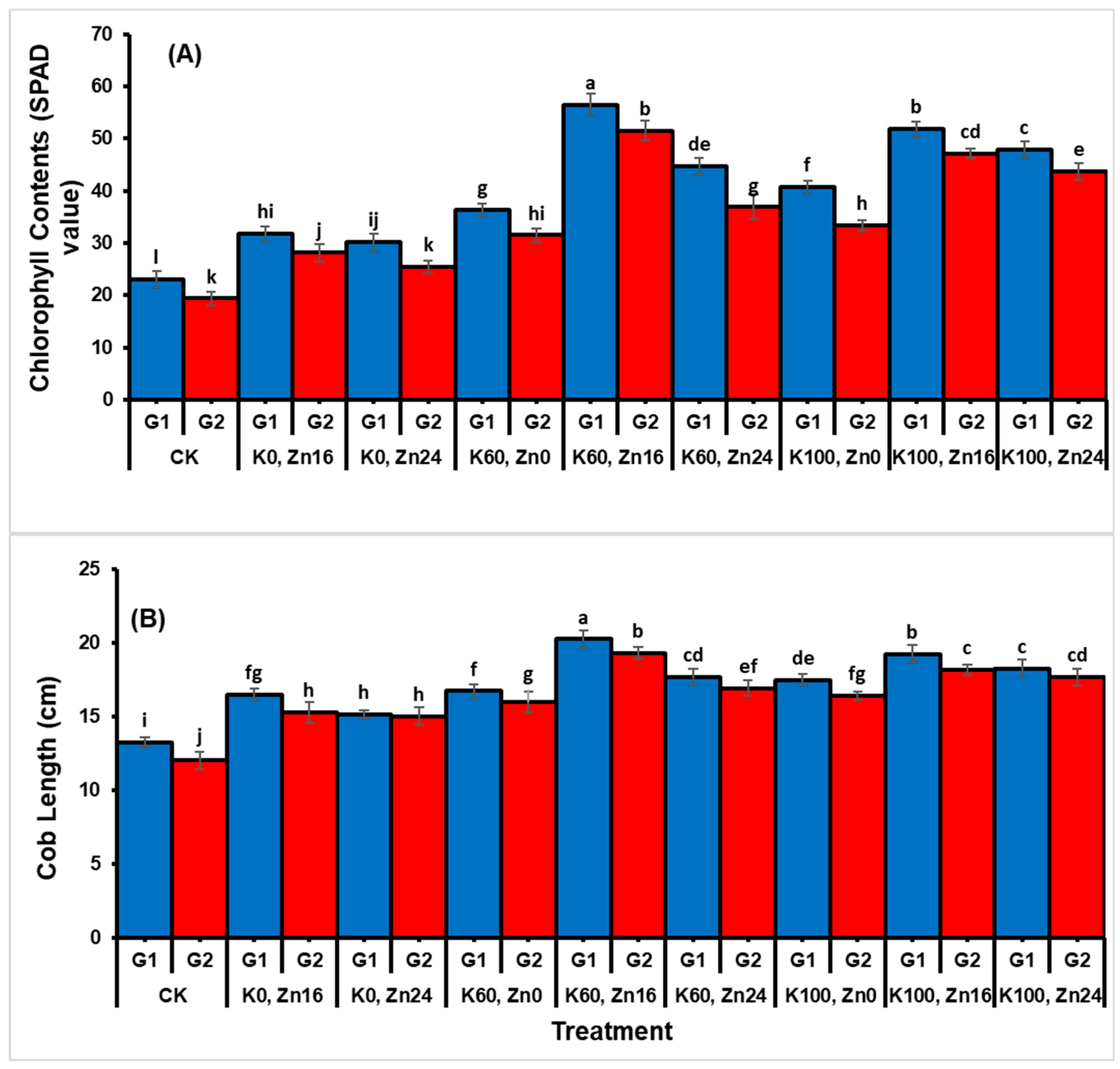



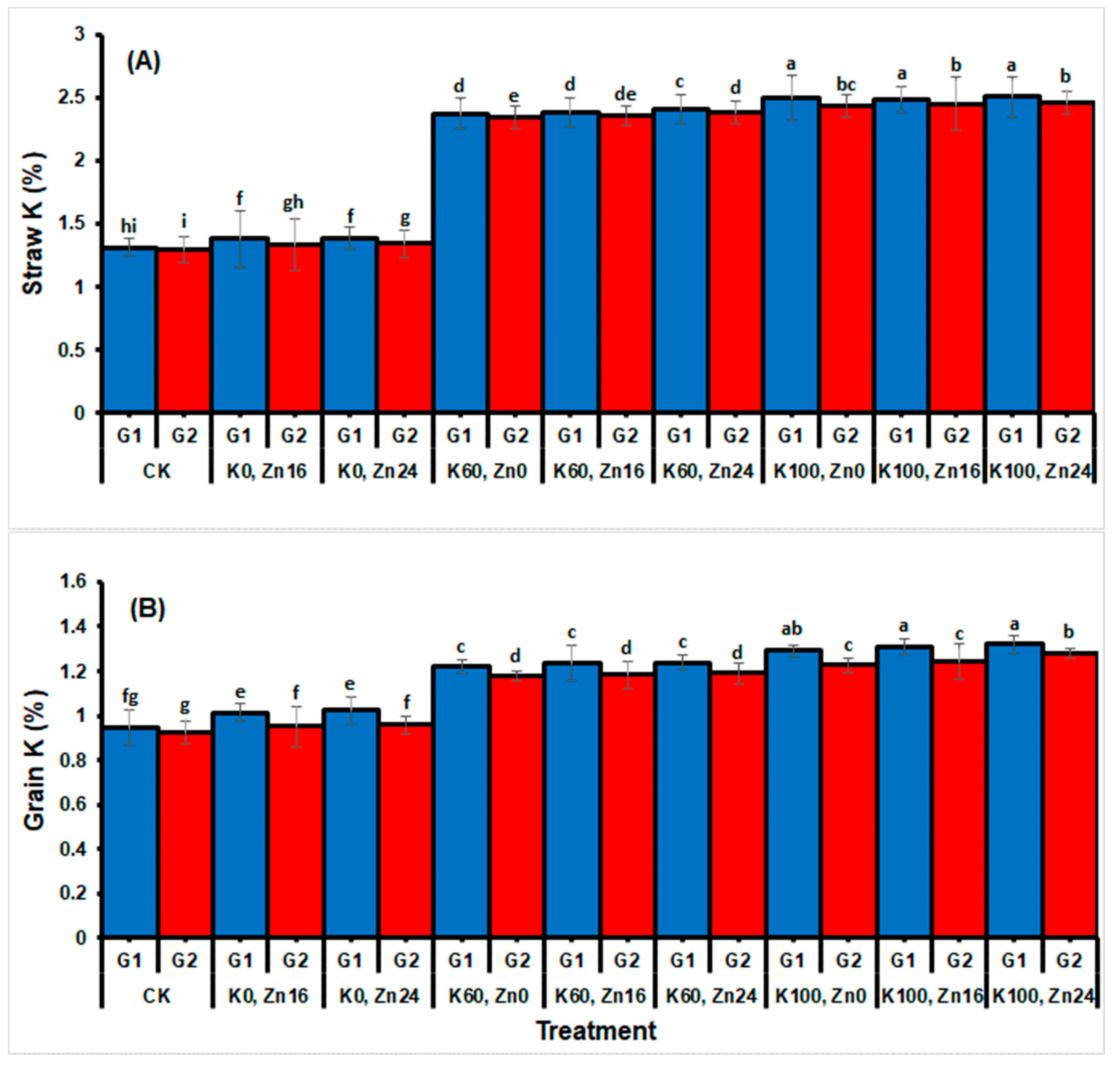
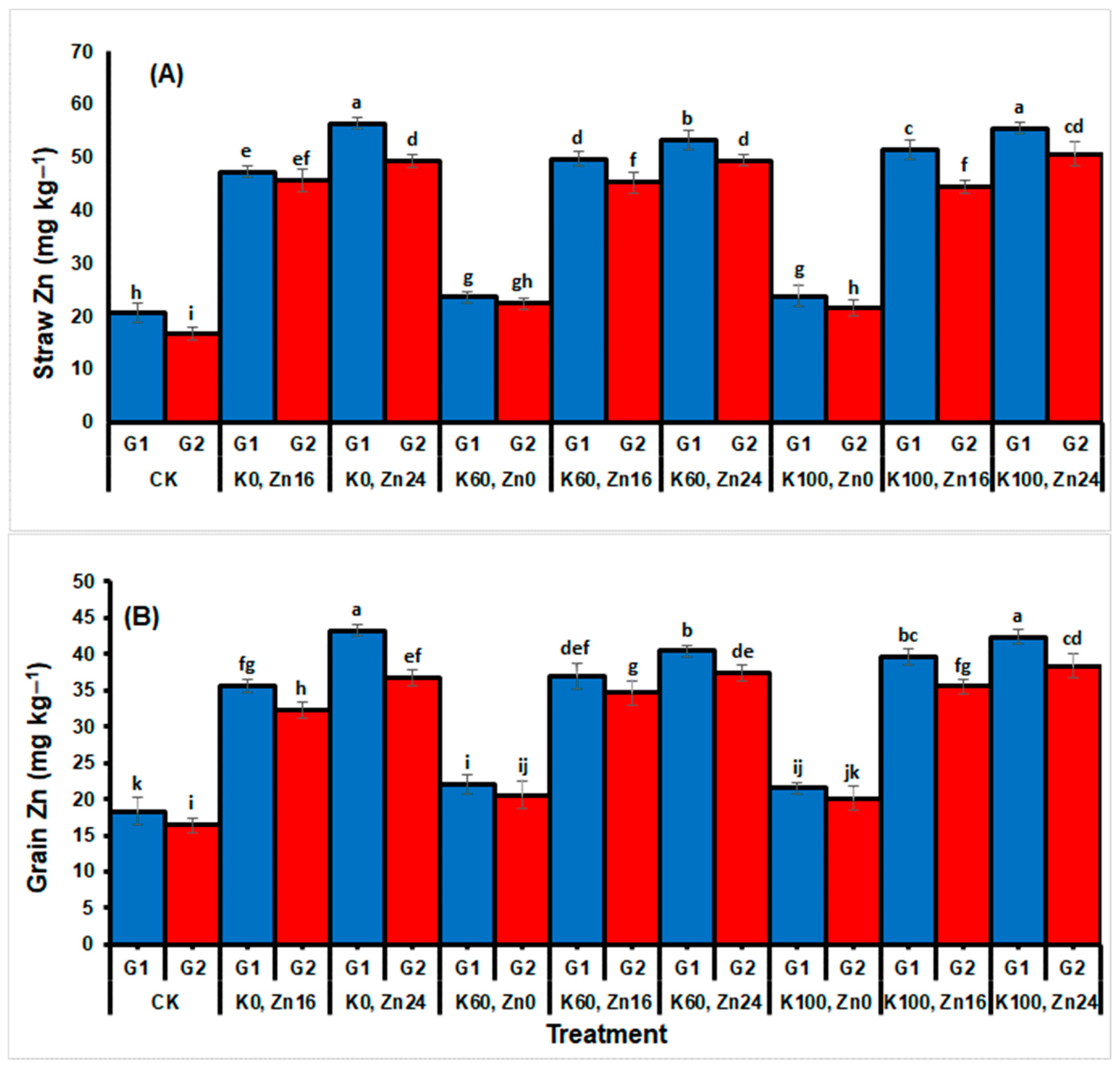
| Character | Unit | Value |
|---|---|---|
| Texture | Loam | |
| Sand | % | 47.6 |
| Silt | % | 34.2 |
| Clay | % | 18.2 |
| PHs | --- | 8.43 |
| EC | dS m−1 | 0.72 |
| CaCO3 | % | 4.67 |
| Bulk density | Mg m−3 | 1.30 |
| Organic matter | % | 0.57 |
| AB-DTPA Extractable Zn | mg kg−1 | 0.54 |
| Extractable K | mg kg−1 | 75.0 |
Publisher’s Note: MDPI stays neutral with regard to jurisdictional claims in published maps and institutional affiliations. |
© 2021 by the authors. Licensee MDPI, Basel, Switzerland. This article is an open access article distributed under the terms and conditions of the Creative Commons Attribution (CC BY) license (https://creativecommons.org/licenses/by/4.0/).
Share and Cite
Ali Raza, H.M.; Bashir, M.A.; Rehim, A.; Raza, Q.-U.-A.; Khan, K.A.; Aon, M.; Ijaz, M.; Ur Rahman, S.; Ahmad, F.; Geng, Y. Effect of K and Zn Application on Biometric and Physiological Parameters of Different Maize Genotypes. Sustainability 2021, 13, 13440. https://doi.org/10.3390/su132313440
Ali Raza HM, Bashir MA, Rehim A, Raza Q-U-A, Khan KA, Aon M, Ijaz M, Ur Rahman S, Ahmad F, Geng Y. Effect of K and Zn Application on Biometric and Physiological Parameters of Different Maize Genotypes. Sustainability. 2021; 13(23):13440. https://doi.org/10.3390/su132313440
Chicago/Turabian StyleAli Raza, Hafiz Muhammad, Muhammad Amjad Bashir, Abdur Rehim, Qurat-Ul-Ain Raza, Kashif Ali Khan, Muhammad Aon, Muhammad Ijaz, Shafeeq Ur Rahman, Fiaz Ahmad, and Yucong Geng. 2021. "Effect of K and Zn Application on Biometric and Physiological Parameters of Different Maize Genotypes" Sustainability 13, no. 23: 13440. https://doi.org/10.3390/su132313440
APA StyleAli Raza, H. M., Bashir, M. A., Rehim, A., Raza, Q.-U.-A., Khan, K. A., Aon, M., Ijaz, M., Ur Rahman, S., Ahmad, F., & Geng, Y. (2021). Effect of K and Zn Application on Biometric and Physiological Parameters of Different Maize Genotypes. Sustainability, 13(23), 13440. https://doi.org/10.3390/su132313440








